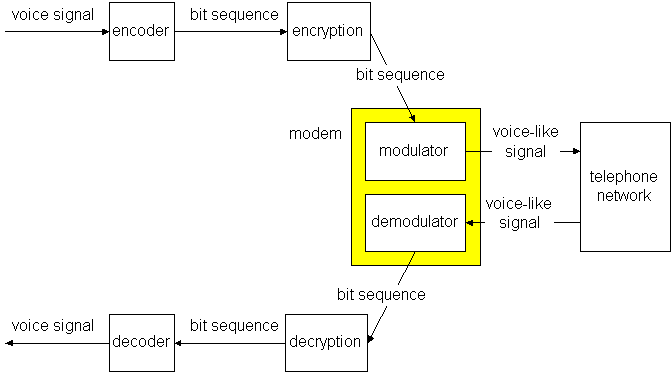Modems
We have seen that DTMF signals can be used to convey numeric information (such as phone numbers or account numbers) via circuits designed for voice. These circuits, which make up the global telephone network, are also a critical link in the internet, which is a global digital network. What we mean by digital is that the information that flows on the internet is bit sequences. A bit sequence is a function:
where Indices ⊂ Naturals and Bits = {0, 1}. Just as with DTMF signaling, in order for a bit sequence to traverse a phone line, it has to be transformed into something that resembles a voice signal. Further, a system is needed to transform the voice-like signal back into a bit sequence. A system that does that is called a voiceband data modem. The word modem is a contraction of modulator, demodulator. Here is a depiction of a typical arrangement:

One option would be to use something similar to DTMF signaling. In the early days of voiceband data modems, this is exactly what was done. Two tones were used, one to represent a '0' and the other to represent a '1'. An audio signal sent through the telephone network consisted of a rapid sequence of these tones. Bit rates achievable by this technique, however, never exceeded 300 bits per second.
Modern modems achieve rates more than 100 times higher using more sophisticated techniques. Although the details of these techniques are beyond the scope of this course, the basic idea is the same. A bit sequence is transformed into an audio signal that can traverse a telephone channel. Here is what a typical modem signal sounds like:
It requires quite a sophisticated device, with some very elaborate signal processing, to extract a bit sequence from such a sound. That is the modem receiver, and it is indeed quite a sophisticated device.
Recall that sound is
Thus, the modem transmitter implements a function that maps a function BitSequence into a function Sound. Let BitSequences = [Indices → Bits] be the set of all bit sequences (each a function BitSequence), and Sounds = [Time → Pressure] be the set of sounds (each a function Sound). Then the modem transmitter implements a function
Both the domain and the range of this function are sets of functions.
Pairs of modems are used at opposite ends of a telephone connection, each with a transmitter and a receiver to achieve bidirectional (called full duplex) communication. Once such modems are in place, and once they have been connected via the telephone network, then they function as a bidirectional "bit pipe." That bit pipe is then usable by other systems.
One of the strangest uses is to transmit digitally represented and encrypted voice signals. Here is a depiction of this relatively complicated arrangement:

What is actually sent through the telephone network sounds like this:
Not only does this provide effective protection against casual listeners, it even provides protection against sophisticated listeners. A listener that is able to extract the bit sequence from this sound will still not be able to reconstruct the voice signal because the bit sequence is encrypted.
Only one end is shown. The encoder and decoder, which convert voice signals to and from bit sequences, are fairly sophisticated systems, as are the encryption and decryption systems. The fact that such an approach is cost effective has more to do with economics than technology.
Modems are used for many other channels besides the telephone channel. Digital transmission over radio, for example, requires that the bit sequence be transformed into a radio signal that conforms with regulatory constraints on that radio signal. Digital transmission over electrical cable requires transforming the bit sequence into a form that propagates well over such cable and that does not radiate too much radio-frequency interference. Digital transmission over optical fiber requires transforming the bit sequence into a light signal, usually with the intensity being modulated at very high rates.

 Up to Topics
Up to Topics Previous
Previous Next
Next